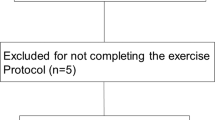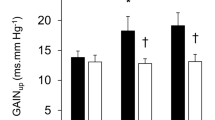Abstract
Purpose
The aim of the present investigation was to assess the role of aging on the contribution of diastolic function during metaboreflex activation. In particular, it aimed to determine whether age-related impairment in diastolic function would produce a different hemodynamic response in elderly subjects (EG) as compared to young controls (CTL).
Methods
Hemodynamic response to metaboreflex activation obtained by post-exercise muscle ischemia (PEMI) was gathered in 22 EG and 20 healthy CTL. Subjects also performed a control exercise recovery (CER) test to compare data from the PEMI test.
Results
The main results showed that the EG group reached higher mean arterial blood pressure (MAP) increment than the CTL group during the PEMI test (+11.2 ± 8.6 vs 6.1 ± 6.4 mmHg in the EG and CTL group, respectively). Moreover, the mechanism by which this response was achieved was different between the two groups. In detail, EG reached the target MAP by increasing systemic vascular resistance (+235.2 ± 315.1 vs −44.4 ± 167.7 dynes s−1 cm−5 for the EG and the CTL group, respectively), whereas MAP response in the CTL was the result of an increase in cardiac pre-load (−1.5 ± 11.2 vs 14 ± 13.7 ml in end-diastolic volume for the EG and the CTL group, respectively), which led to a rise in stroke volume and cardiac output. Moreover, early filling peak velocities showed a higher response in the CTL than EG group.
Conclusions
This study demonstrates that diastolic function is important for normal hemodynamic adjustment during the metaboreflex and to avoid excessive vasoconstriction.




Similar content being viewed by others
Abbreviations
- A vel:
-
Atrial transmitral filling peak velocity
- BP:
-
Blood pressure
- CER:
-
Control exercise recovery
- CO:
-
Cardiac output
- CPX:
-
Cardiopulmonary test
- CTL:
-
Controls subjects
- DBP:
-
Diastolic blood pressure
- DT:
-
Diastolic time
- E vel:
-
Early transmitral filling peak velocity
- EDV:
-
End-diastolic volume
- EF:
-
Ejection fraction
- EG:
-
Elderly subjects
- ESV:
-
End-systolic volume
- HR:
-
Heart rate
- LVET:
-
Left ventricular ejection time
- MAP:
-
Mean blood pressure
- PEMI:
-
Post-exercise muscle ischemia
- PEP:
-
Pre-ejection period
- PWD:
-
Pulse wave Doppler
- SBP:
-
Systolic blood pressure
- SV:
-
Stroke volume
- SVR:
-
Systemic vascular resistance
- VFR:
-
Ventricular filling rate
References
Alam M, Smirk FH (1937) Observations in man upon a blood pressure raising reflex arising from the voluntary muscles. J Physiol 89:372–383
Amann M, Runnels S, Morgan DE, Trinity JD, Fjeldstad AS, Walter Wray D, Reese VR, Richardson RS (2011) On the contribution of group III and IV muscle afferents to the circulatory response to rhythmic exercise in humans. J Physiol 589:3855–3866
Arbab-Zadeh A, Dijk E, Prasad A, Fu Q, Torres P, Zhang R, Thomas JD, Palmer D, Levine BD (2004) Effect of aging and physical activity on left ventricular compliance. Circulation 110:1799–1805
Baldi JC, McFarlane K, Oxenham HC, Whalley GA, Walsh HJ, Doughty RN (2003) Left ventricular diastolic filling and systolic function of young and older trained and untrained men. J Appl Physiol 95:2570–2575
Baldi JC, Lalande S, Carrick-Ranson G, Johnson BD (2007) Postural differences in hemodynamics and diastolic function in healthy older men. Eur J Appl Physiol 99:651–657
Bastos BG, Williamson JW, Harrelson T, Nôbrega ACL (2000) Left ventricular volumes and hemodynamic responses to postexercise ischemia in healthy humans. Med Sci Sports Exerc 32:1114–1118
Bernstein DP (1986) A new stroke volume equation for thoracic electrical bioimpedance: theory and rationale. Crit Care Med 14:904–909
Boushel R (2010) Muscle metaboreflex control of the circulation during exercise. Acta Physiol 199:367–383
Christie J, Sheldahl LM, Tristani FE, Sagar KB, Ptacin MJ, Wann S (1987) Determination of stroke volume and cardiac output during exercise: comparison of two-dimensional and Doppler echocardiography, Fick oxymetry, and thermodiluition. Circulation 76:539–547
Cohen GI, Pietrolungo JF, Thomas JD, Klein AL (1996) A practical guide to assessment of ventricular diastolic function using Doppler echocardiography. J Am Coll Cardiol 27:1753–1760
Crisafulli A, Melis F, Orrù V, Lener R, Lai C, Concu A (2001) Impedance cardiography for non invasive assessment of systolic time intervals during exercise. Sports Med Train Rehab 10:13–27
Crisafulli A, Scott AC, Wensel R, Davos CH, Francis DP, Pagliaro P, Coats AJS, Concu A, Piepoli MF (2003) Muscle metaboreflex-induced increases in stroke volume. Med Sci Sports Exerc 35:221–228
Crisafulli A, Salis E, Pittau G, Lorrai L, Tocco F, Melis F, Pagliaro P, Concu A (2006) Modulation of cardiac contractility by muscle metaboreflex following efforts of different intensities in humans. Am J Physiol (Heart Circ Physiol) 291:H3035–H3042
Crisafulli A, Salis E, Tocco F, Melis F, Milia R, Pittau G, Caria MA, Solinas R, Meloni L, Pagliaro P, Concu A (2007) Impaired central hemodynamic response and exaggerated vasoconstriction during muscle metaboreflex activation in heart failure patients. Am J Physiol (Heart Circ Physiol) 292:H2988–H2996
Crisafulli A, Milia R, Lobina A, Caddeo M, Tocco F, Concu A, Melis F (2008) Hemodynamic effect of metaboreflex activation in men after running above and below the velocity of the anaerobic threshold. Exp Physiol 93:447–457
Crisafulli A, Milia R, Vitelli S, Caddeo M, Tocco F, Melis F, Concu A (2009) Hemodynamic responses to metaboreflex activation: insights from spinal cord-injured humans. Eur J Appl Physiol 106:525–533
Crisafulli A, Piras F, Filippi M, Piredda C, Chiappori P, Melis F, Milia R, Tocco F, Concu A (2011) Role of heart rate and stroke volume during muscle metaboreflex-induced cardiac output increase: differences between activation during and after exercise. J Physiol Sci 61:385–394
Crisafulli A, Tocco F, Milia R, Angius L, Pinna M, Olla S, Roberto S, Marongiu E, Porcu M, Concu A (2013) Progressive improvement in hemodynamic response to muscle metaboreflex in heart transplant recipients. J Appl Physiol 114:421–427
De Souza RR (2002) Aging of myocardial collagen. Biogerontology 3:325–335
Fisher JP, Seifert T, Hartwich D, Young CN, Secher NH, Fadel PJ (2010) Autonomic control of heart rate by metabolically sensitive skeletal muscle afferents in humans. J Physiol 588:1117–1127
Gardin JM, Dabestani A, Takenaka K, Rohan MK, Knoll M, Russell D, Henry WL (1986) Effect of imaging view and sample volume location on evaluation of mitral flow velocity by pulsed Doppler echocardiogaphy. Am J Cardiol 57:1335–1339
Gledhill N, Cox D, Jamnik R (1994) Endurance athletes’ stroke volume does not plateau: major advantage is diastolic function. Med Sci Sports Exerc 26:1116–1121
Ichinose MJ, Sala-Mercado JA, Coutsos M, Li ZH, Ichinose TK, Dawe E, O’Leary DS (2009) Modulation of cardiac output alters the mechanisms of the muscle metaboreflex pressor response. Am J Physiol (Heart Circ Physiol) 298:H245–H250
Ichinose M, Maeda S, Kondo N, Nishiyasu T (2014) Blood pressure regulation II: what happens when one system must serve two masters-oxygen delivery and pressure regulation? Eur J Appl Physiol 114:451–465
Lakatta EG (2002) Cardiovascular ageing in health sets the stage for cardiovascular disease. Heart Lung and Circ 11:76–91
Marongiu E, Piepoli MF, Milia R, Angius L, Pinna M, Bassareo P, Roberto S, Tocco F, Concu A, Crisafulli A (2013) Effects of acute vasodilation on the hemodynamic response to muscle metaboreflex. Am J Physiol (Heart Circ Physiol) 305:H1387–H1396
McNully CL, Moody WE, Wagenmakers AJ, Fisher JP (2014) Effect of muscle metaboreflex activation on central hemodynamics and cardiac function in humans. App Physiol Nutr Metab 39:861–870
Milia R, Roberto S, Marongiu E, Olla S, Sanna I, Angius L, Bassareo P, Pinna M, Tocco F, Concu A, Crisafulli A (2014). Improvement in hemodynamic responses to metaboreflex activation after one year of training in spinal cord injured humans. Biomed Res Int, ID 893468, http://doi.org/10.1155/2014/893468
Moran D, Epstein Y, Keren G, Laor A, Sherez J, Shapir Y (1995) Calculation of mean arterial pressure during exercise as a function of heart rate. Appl Human Sci 14:293–295
Murphy MN, Mizuno M, Mitchell JH, Smith A (2011) Cardiovascular regulation by skeletal muscle reflexes in health and disease. Am J Physiol (Heart Circ Physiol) 2011(301):H1191–H1204
Nóbrega ACL, O’Leary DS, Silva BM, Marongiu E, Piepoli MF, Crisafulli A (2014). Neural regulation of cardiovascular response to exercise: role of central command and peripheral afferents. Biomed Res Int; 478965, http://doi.org/10.1155/2014/478965
O’Leary DS, Augustyniak RA (1998) Muscle metaboreflex increases ventricular performance in conscious dogs. Am J Physiol (Heart Circ Physiol) 275:H220–H224
O’Leary DS, Sala-Mercado JA, Augustyniak RA, Hammond RL, Rossi NF, Ansorge EJ (2004) Impaired muscle metaboreflex-induced increases in ventricular function in heart failure. Am J Physiol (Heart Circ Physiol) 287:H2612–H2618
O’Leary DS (2006) Altered reflex cardiovascular control during exercise in heart failure: animal studies. Exp Physiol 91:73–77
Oxenham H, Young A, Cowan B, Gentles T, Occleshaw C, Fonseca C, Doughty R, Sharpe N (2003) Age related changes in myocardial relaxation using three-dimensional tagged magnetic resonance imaging. J Cardiovs Magn Reson 5:421–430
Roberto S, Marongiu E, Pinna M, Angius L, Olla S, Bassareo P, Tocco F, Concu A, Milia R, Crisafulli A (2012) Altered hemodynamics during muscle metaboreflex in young, type 1 diabetes patients. J Appl Physiol 113:1323–1331
Sala-Mercado JA, Hammond RL, Kim JK, Rossi NF, Stephenson LW, O’Leary DS (2006) Muscle metaboreflex control of ventricular contractility during dynamic exercise. Am J Physiol (Heart Circ Physiol) 290:H751–H757
Sheriff DD, Augstyniak RA, O’Leary DS (1998) Muscle chemoreflex-induced increases in right atrial pressure. Am J Physiol (Heart Circ Physiol) 275:H767–H775
Shoemaker JK, Mattar L, Kerbeci P, Trotter S, Arbeille P, Hughson RL (2007) WISE 2005: stroke volume changes contribute to the pressor response during ischemic handgrip exercise in women. J Appl Physiol 103:228–233
Spranger MD, Sala-Mercado JA, Coutsos M, Kaur J, Styer D, Augustyniak RA, O’Leary DS (2013) Role of cardiac output vs peripheral vasoconstriction in mediating muscle metaboreflex pressor responses: dynamic exercise vs post-exercise muscle ischemia. Am J Physiol (Regul Integr Comp Physiol) 304:R657–R663
Strange S, Secher NH, Pawelczyk JA, Karpakka J, Christensen NJ, Mitchell JH, Saltin B (1993) Neural control of cardiovascular responses and of ventilation during dynamic exercise in man. J Physiol 470:693–704
Stratton JR, Levy WC, Cerqueira MD, Schwartz RS, Abrass IB (1994) Cardiovascular responses to exercise. Effects of aging and exercise training in healthy men. Circulation 89:1648–1655
Acknowledgments
This study was supported by the University of Cagliari, the Italian Ministry of Scientific Research and the Regional School of Sport of Sardinia, Italian Olympic Committee (Italy). The authors wish to thank Mr. Barry Mark Wheaton for his editorial assistance.
Conflict of interest
The authors have no conflicts of interest that are directly relevant to the content of this manuscript.
Ethical standards
Each subject gave written informed consent to take part in the study, which was approved by the local ethical committee and conforms to the principles of the Declaration of Helsinki.
Author information
Authors and Affiliations
Corresponding author
Additional information
Communicated by David C. Poole.
Rights and permissions
About this article
Cite this article
Milia, R., Roberto, S., Mulliri, G. et al. Effect of aging on hemodynamic response to metaboreflex activation. Eur J Appl Physiol 115, 1693–1703 (2015). https://doi.org/10.1007/s00421-015-3153-5
Received:
Accepted:
Published:
Issue Date:
DOI: https://doi.org/10.1007/s00421-015-3153-5




